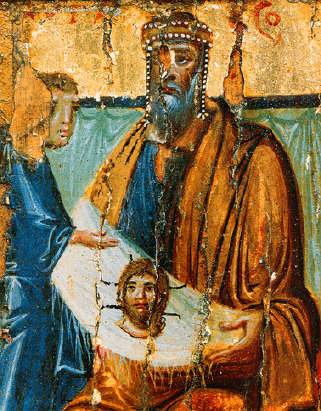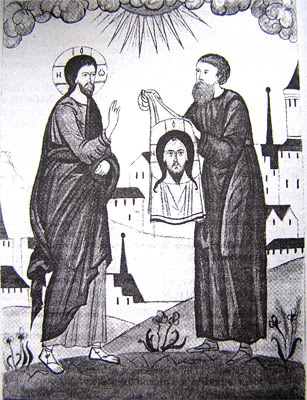
https://en.wikipedia.org/wiki/File:Abga … entury.jpg
The image of Edessa (Mandylion) is tied to the legend of King Abgar V.
According to Christian tradition, the Image of Edessa was a holy relic consisting of a square or rectangle of cloth upon which a miraculous image of the face of Jesus had been imprinted—the first icon (“image”). The image is also known as the Mandylion (from Greek μανδύλιον “cloth, towel”), in Eastern Orthodoxy, it is also known as Acheiropoeiton (Εἰκόν’ ἀχειροποίητη), or “icon not made by hand”.In the tradition recorded in the early 4th century by Eusebius of Caesarea, King Abgar of Edessa wrote to Jesus, asking him to come cure him of an illness. Abgar received a reply letter from Jesus, declining the invitation, but promising a future visit by one of his disciples. One of the seventy disciples, Thaddeus of Edessa, is said to have come to Edessa, bearing the words of Jesus, by the virtues of which the king was miraculously healed.
https://en.wikipedia.org/wiki/Image_of_Edessa
The earliest full account of the icon, the fourth-century Syriac Teaching of
Addai, describes it as a painting of Jesus’ face made from life during his ministry by
Hanan, an agent of ailing King Abgar V of Edessa (13-50 CE). Remarkably, the
anonymous author comments on the “choice paints” used by Hanan, while omitting
mention of the medium, whether wood, parchment, or cloth. According to this account,
Abgar was healed by the painting and became a Christian.All subsequent texts, however, consider the icon to be a large cloth, and
miraculously made. The usual Greek descriptor for this, (acheiropoietos), “not made by
human hands,” was first suggested by the historian Evagrius, writing in the late sixth
century. The Acts of Thaddaeus (Greek for Addai already in the version of Eusebius,
who did not mention the icon) was a major retelling of the Abgar legend. Though its
earliest MS dates from the ninth century, it is thought to derive from a sixth-century
original. The anonymous author of this account says the brill iance surrounding Jesus’
face prevented Abgar’s messenger from achieving the portrait, so Jesus wiped his face
on a tetradiplon and left its impression on “this sindon.” Tetradiplon is no word for
towel; it suggests a cloth seen folded in eight layers. Sindon is the NT synoptic word
for Jesus’ burial cloth.Descriptions of its Edessan rituals indicate that it had been
shown to the masses only rarely and amidst mysterious ritual. Thus there were few
individuals who had personally experienced it. So secretly was this icon kept that, as
with the Grail, its true nature was not precisely known. As the Grail accounts differ
from one another regarding its “whatness,” so also do the terms used by Greeks or
Westerners for this icon differ. In texts we find mandylion, mantile, sancta toella,
imago, linteum, manutergium, ektypoma, tetradiplon, sindon, soudarion, and the plurals
spargana, panni, fasciae, othonai, sindones–and the list is not exhaustive.In one of its early rituals in Edessa before 944 and
possibly in Constantinople from 944 until it was lost in 1204, it was unfolded to suggest
first the infant Jesus and then, by a gradual series of changes throughout the day, the
crucified Jesus.. . . on Easter it used to change its appearance according to different ages: it showed
itself in infancy at the first hour of the day, childhood at the third hour, adolescence at the sixth
hour, and the fullness of age at the ninth hour, when the Son of God came to His Passion . . .
and . . . cross .
https://www.shroud.com/pdfs/n56part3.pdf
The image of Edessa and the TS share common similarities in their history.
The first record of the existence of a physical image in the ancient city of Edessa (now Urfa) was by Evagrius Scholasticus, writing about 593, who reports a portrait of Christ of divine origin (θεότευκτος), which effected the miraculous aid in the defence of Edessa against the Persians in 544. The image was moved to Constantinople in the 10th century. The cloth disappeared when Constantinople was sacked in 1204 during the Fourth Crusade, and is believed by some to have reappeared as a relic in King Louis IX of France’s Sainte-Chapelle in Paris.The Mandylion remained under Imperial protection until the Crusaders sacked the city in 1204 and carried off many of its treasures to Western Europe, though the “Image of Edessa” is not mentioned in this context in any contemporary document. Similarly, it has been claimed that the Shroud of Turin disappeared from Constantinople in 1204, when Crusaders looted the city. The leaders of the Crusader army in this instance were French and Italian (from Venice), and it is believed that somehow because of this, the Shroud made its way to France.[16] A small part of a relic, believed to be the same as this, was one of the large group sold by Baldwin II of Constantinople to Louis IX of France in 1241 and housed in the Sainte-Chapelle in Paris (not to be confused with the Sainte Chapelle at Chambéry, home for a time of the Shroud of Turin) until it disappeared during the French Revolution.[6]
https://en.wikipedia.org/wiki/Image_of_Edessa
Though the image of Edessa is commonly depicted with only the head of Jesus, it actually also involves a long cloth.

https://commons.wikimedia.org/wiki/File … ntines.jpg

https://www.johnsanidopoulos.com/2016/0 … -holy.html

https://www.johnsanidopoulos.com/2016/0 … -holy.html
The Mandylion icon was actually a scarf or shroud which was considered to have on it the image of Jesus Christ.
https://www.worldhistory.org/edessa/
It makes the most sense that the image of Edessa (Mandylion) and the TS is the same thing.
It seems that the Mandylion story was based on the actual conversion to Christianity of a later king of the same name, Abgar IX (r. 179-216 CE). Whatever the origins of the story, the important fact was that the people of Edessa, along with many others in the Christian world, believed it to be true. Further, the image on the miracle icon, probably the first relic its kind, was copied in many wall-paintings and domes in churches around Christendom as it became the standard representation known as the Pantokrator (All-Ruler) with Christ full frontal holding a Gospel book in his left hand and performing a blessing with his right. The image would also inspire the design of coins of the Byzantine Empire. The Mandylion had other influences, too, the icon being frequently cited in theological arguments for Christ’s incarnation as a real man during the Middle Ages.
https://debatingchristianity.com/forum/viewtopic.php?p=1122237#p1122237
